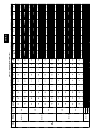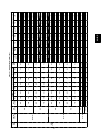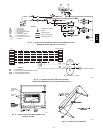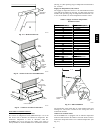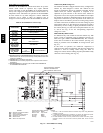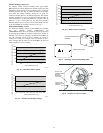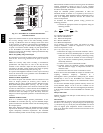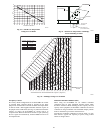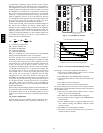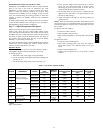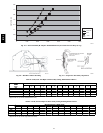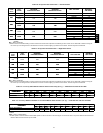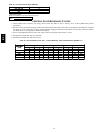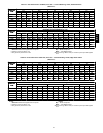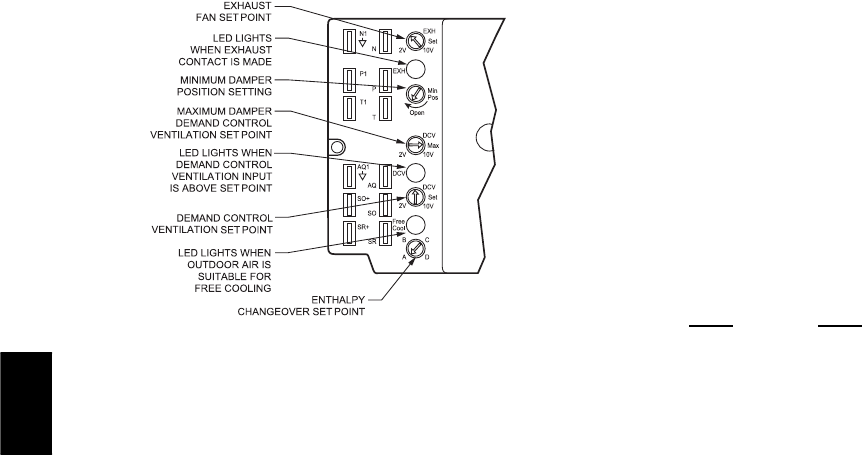
28
C06034
Fig. 33 --- EconoMi$er IV Contro ller Potentiometer
and LED Locations
Replace the standard outside air dry bulb temperature sensor with
the accessory enthalpy sensor in the same mounting location.
(See Fig. 21.) Mount the return air enthalpy sensor in the return
air duct. (See Fig. 35.) Wiring is provided in the EconoMi$er IV
wiring harness. (See Fig. 27.) The outdoor enthalpy changeover
set point is set with the outdoor enthalpy set point potentiometer
on the EconoMi$er IV controller. When using this mode of
changeover control, turn the enthalpy setpoint potentiometer fully
clockwise to the D setting.
Indoor Air Quality (IAQ) Sensor Input
The IAQ input can be used for demand control ventilation control
based on the level of CO
2
measur ed in the space or return air
duct.
Mount the accessory IAQ sensor according to manufacturer
specifications. The IAQ sensor is wired to the AQ and AQ1
terminals of the controller. Adjust the DCV potentiometers to
correspond to the DCV voltage output of the indoor air quality
sensor at the user-determined set point. (See Fig. 38.)
If a separate field-supplied t ransformer is used to power the IAQ
sensor, the sensor must not be grounded or the EconoMi$er IV
control board will be damaged.
Exhaust Set Point Adjustment
The exhaust set point will determine when the exhaust fan runs
based on dampe r position (if accessory power exhaust is
installed). The set point is modified with the Exhaust Fan Set
Point (EXH SET) potentiometer. (See Fig. 33.) The set point
represents the damper pos ition above which the exhaust fans will
be turned on. When there is a call for exhaust, the EconoMi$er IV
controller provides a 45 15 second delay before exhaust fan
activation to allow the da mpers to open. This delay allows the
damper to reach the appropriate position to avoid unnecessary fan
overload.
Minimum Position Control
There is a mini mum damper position potentiometer on the
EconoMi$er IV controller. (See Fig. 33.) The minimum damper
pos ition maint ains the minimum airflow into the building during
the occupied period.
When using demand v entilation, the minimum damper position
represents the m inimum ventilation position for VOC (volatile
organic compound) ventilation requirement s. The maximum
demand ve ntilation position is used for fully occupied ventilation.
When demand ventilation c ontrol is not being used, the minimum
pos ition potentiometer should be used to set the occupied
ventilation position. The maximum demand ventilation position
should be turned fully clockwise.
Adjust the minimum position potentiometer to allow the
minimum amount of outdoor air, as required by local codes, to
enter the building. Make minimum pos ition adjustments with at
least 10_F temperature difference between the outdoor and
return-air temperatur es.
To determine the m inimum position setting, pe rform the
following procedure:
1. Calculate the appropriate mixed air temperature using the
following formula:
(
T
OA
)
+
(
T
R
x
RA
)
T
(
T
Ox
100
)
+
(
T
R
x
100
)
=T
M
T
O
= Outdoor-Air Temperature
OA = Percent of O ut door Air
T
R
= Return-Air Te m perature
RA = Percent of Return Air
T
M
= Mixed-Air T emperature
As an example, if local codes require 10% outdoor air during
occupied conditions, outdoor-air temperature is 60_F, and
return-air temperature is 75_F.
(60 x .10) + (75 x .90) = 73.5_F
2. Disconnect the supply air sensor from terminals T and T1.
3. Ensure that the factory-installed jumper is in place acros s
terminals P and P1. If remote damper positioning is being
used, make sure that the terminals are wired according to
Fig. 27 and t hat the mi nimum pos ition potentiometer is
turned fully clockwise.
4. Connect 24 vac across terminals TR and TR1.
5. Carefully adjust the minimum position potentiometer
until the measured supply air temperature matches the
calculated value.
6. Reconnect the mixed air sensor to terminals T and T1.
Remote control of the EconoMi$er IV damper is desirable when
requiring additional temporary ventilation. If a
field-supplied remote potentiometer (Honeywell part number
S963B1128) is wired to the EconoMi$er IV controller, the
mini mum position of the damper can be controlled from a remote
location.
To co ntrol the minimum dampe r pos ition remotely, remove the
factory-installed jumper on the P and P1 terminals on the
EconoMi$er IV controller. Wire the field-supplied potentiometer
to the P and P1 terminals on the EconoMi$er IV controller. (See
Fig. 37.)
Damper Movement
Damper movement from full open to full closed (or vice versa)
takes 2
1
/
2
minutes.
Thermostats
The EconoMi$er IV control works with conventional thermostats
that have a Y1 (cool stage 1), Y2 (cool stage 2), W1 (heat stage
1), W2 (heat stage 2), and G (fan). The EconoMi$er IV control
does not support space temperature sensors. Connections are
made at the thermostat terminal connection board located in the
main control box.
551B,C



